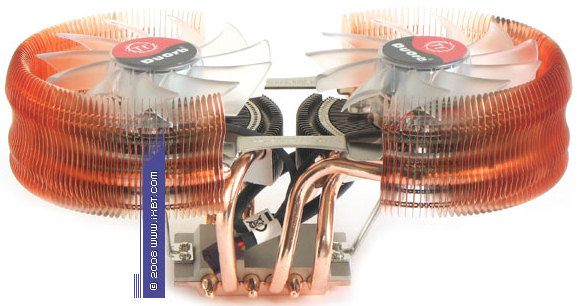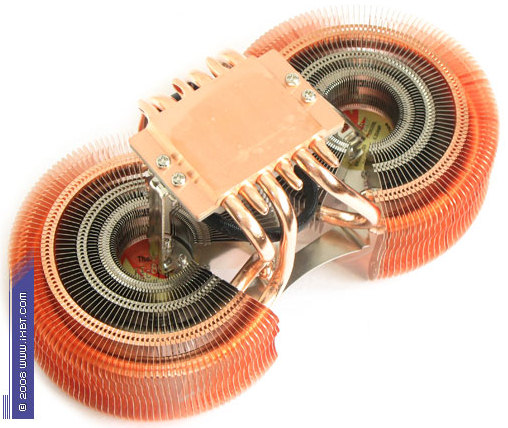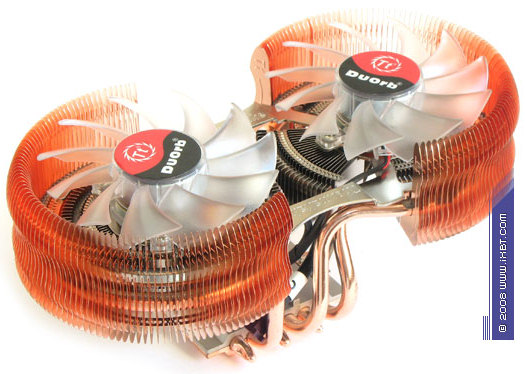As tradition demands, practically all technological PC cooling solutions initially pass through a pilot stage on processors, and only after proper adaptation they are transferred to the target segment. That's what happened with copper heatsinks that ended their CPU cycle and got a transfer to cooling devices for GPUs, motherboard components, memory modules, etc. The same genealogy can be traced in the personal file of famous heat pipes -- CPU approbation of various configurations has almost always produced decent results, so you cannot find any group of cooling devices without them. That is, the above-mentioned trend kept strictly to the principle "from the hardest to the simplest". In fact, it was necessary to solve the primary task, which was loaded with several minor related problems.
However, our product under review, Thermaltake DuOrb CPU cooler (launched this spring), dares to violate the general principles: its ideological prototype was a dual-head DuOrb GPU cooler, not a CPU cooler. Indeed, why not? Formally and from the purely practical point of view, there seems to be no problems to reverse the implementation from the "secondary" cooling system to the "primary" one. It all looks peachy.
Well, let's examine today's original solution and try to determine how justified this unusual concept of Thermaltake engineers is. But what concerns our reviewing, we shall not modify the established test procedures yet -- as always, we'll start with design and usability of DuOrb CPU, and then we'll proceed to its test results.
Design
Probably the main highlight of DuOrb CPU is that very idea behind the original product from the graphics series -- our product under review copies the original dual-head and dual-fan design with mandatory improvements.
Adapted for CPU cooling, this device certainly grows taller, but its original combination of compact size and thermal readiness is preserved. It's relatively small (202x106x88 mm), but it offers a promising combination of two radial cups of copper-aluminum finning, a copper base (64x40x6 mm, 45x40 mm at the bottom), six copper heat pipes (6 mm in diameter), and two open fans (80x80x20 mm, nominal rotational speed -- 2000 rpm).

DuOrb for graphics cards was designed for indirect cooling of memory chips and a voltage regulator of the graphics card. But DuOrb CPU can now ventilate the near-socket area and memory modules owing to the similar geometry of the working medium. It's easy to guess that it makes this cooler much more promising for compact systems (mini PC cases, HTPC), which are often characterized by unfavorable thermal conditions and high requirements to dimensions of cooling systems (by the way, DuOrb CPU is doing great from this point of view -- its height does not exceed 90 mm, that is it easily complies with the wide-spread height requirement of mini cases -- 95-100 mm).

Configuration of our product under review is also very interesting. First of all, we should mention that each cup of fins is split into three independent sections for individual care of heat pipes -- an external section (90 copper fins, 15x45 mm) and two inner sections, big and small (67 aluminum fins 22x18 mm, and 24 aluminum fins 30x18 mm). We've already seen this feature in MaxOrb coolers -- coordinated operation of their heat pipes and individual fin-stacks were very efficient. So we have every right to hope for well-coordinated operation of DuOrb CPU, which is formed by the same advanced set of heat pipes and fins with optimized heat exchange surface area (about 3000 cm2 in total).
Another important point -- DuOrb CPU offers reasonable and effective redistribution of heat pipes in fin-stacks: two central pipes, the most loaded ones, go to the external sections (best ventilation), two internal pipes work with small inner sections (which are also installed in the comfortably ventilated zone), and two peripheral pipes work with the big inner sections, which large heat exchange surface area makes up for impeded ventilation. Another praiseworthy moment -- technically correct coupling of all elements of the heatsink -- the base, pipes, and fins are all soldered to guarantee proper intensification of heat exchange.

On-board fans Everflow T128020SL also look good -- they can boast of an efficient 11-blade impeller and demonstrate acceptable technical quality (sleeve bearing and simple neat electronics). However, their whimsical aerodynamic installation (clearance between the impellers is just about one centimeter) provokes our critical remark: opposing rotation of the impellers generates unpleasant acoustic effects (sort of bobbling, which disappears only in low-speed modes) and indirectly contributes to the deterioration of the flow characteristic of the fans. Thermaltake engineers still have some job to do -- a special aerodynamic element (for example, a plastic cover or something else to separate the impellers) would have been apparently welcome in DuOrb CPU.
Write a comment below. No registration needed!




